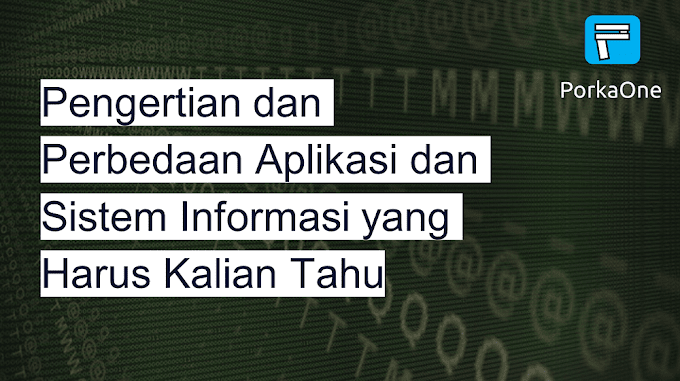
System
The system is a unity of elements or components, then each of these components
or elements work together, complement each other to produce a goal. There are
many examples of systems around us, we take the example of a motorbike. A
motorbike is a system, consisting of many components, there are tires, tanks,
lights, brakes, gas, etc. Another example is humans. Humans are a system,
components or elements in which there are hands, feet, head, body, etc.
If you have ever used an academic information system it is another example of
a system. Inside there are modules or menus. We can also call it an element or
component of the system itself. Components of the academic information system
include student data collection modules, teacher data collection modules,
class data collection modules, subject data collection modules, and other
modules.
Based on the example above, I think you already know other examples of systems around you. So the system is a collection of elements or components or elements and each element or component or elements are interconnected with each other or work together to be able to achieve certain goals.
System Characteristics
The basic concept of a system is consisting of input, process and output. Then according to Sutabri (2012), a system can be said to be a good system if it has certain characteristics. An explanation of the characteristics of the system through the image below.A. System Components
As I explained before, every system has components that interact with each other in a system. We can call this component a module, element, element and even a sub-system again. An example is a motor, a motor as a system has a brake element or elements. We can call this brake a subsystem, because brakes also have components in them.B. System Boundaries
Each system has its own limitations. This is what makes the system look like a single unit. And this barrier is what makes it limited by other systems. For example, human hands and feet. Hands and feet are each have their limits. Hands are not like legs and feet are not like hands, hands function to eat and feet function to walk, both have their respective functions, this function also creates a limit itself.C. System Environment
The system environment is the place where the system resides. The system environment can affect the work of the system itself. Examples of the environment of a system are vendors, customers, governments, banks, etc. While the system is a computer shop that we have.D. System Interface
To be able to work together between subsystems, components, elements or elements in a system, of course there must be a bridge or link, otherwise the system cannot work optimally or even cannot work. An example is the components inside a computer, each component such as ram, processor, battery, screen, etc. must work together so that the computer can turn on.E. System Input
System input can be anything, data or activity. For example, when we assess a subject, we need to enter the child's name and then the value of each aspect.F. System Output
Every input will be processed, after processing it will produce something. Like the example of the subject assessment, we need to enter the name of the child and the value of each aspect. The final result or output that we will get is the total average value of each aspect that we have input before.G. System Process
Before producing something, the system must process it. Examples of this process can be a process that is carried out manually, mechanically, or automatically. Like entering the value of the subject. Then the process will be carried out automatically through the system.H. System Objective
Besides outputs. The system has a goal or purpose. This becomes a parameter whether the system is successful in carrying out its duties or not. Like the previous example, when we enter the value of the subject, the value generated from the system must match the correct mathematical calculations. We don't care if the child's grades are big or small, the most important thing is that the system can work according to procedures. And this is what distinguishes the objective and output of a system.System classification
Systems can be distinguished or classified into several types, the following system classifications are:A. Abstract Systems and Physical Systems
An abstract system is a system in the form of an idea or thought, this type of system does not appear physically, for example, a religious system or a theological system, another example is a system of rules. While the physical system is the opposite of an abstract system, namely a system that can be physically seen, for example, is a computer system.B. Natural Systems and Artificial Systems
Natural systems are systems that are formed or created automatically by nature, or these systems are not made by humans. Examples are the solar system and galaxies, the human digestive system, the reproductive system. While artificial systems are systems made by humans. For this system, there are many examples, but in essence, all systems that have human intervention in the manufacturing process are artificial systems. Examples are computer systems, rules or policies, electrical systems, etc.C. Deterministic Systems and Probabilistic Systems
A deterministic system is a system whose outcome can be predicted. An example is a computer system, we know the results for sure, because we ourselves want what the computer will and should produce. Meanwhile, a probabilistic system is a system whose results cannot be predicted with certainty, for example, a human system or a weather system.D. Open System and Closed System
An open system is a system that is limited and influenced by its external environment. In particular, it is also known as an automated system, which is part of an artificial system that interacts with the control of one or more computers as part of the system used in modern society. This system takes input and produces output for other subsystems, for example the human culture system. While a closed system is a system that is not limited and is not affected by the outside environment. Without outside interference, this system can work automatically. Theoretically such systems exist, but in practice there are no truly closed systems, only relatively closed (relatively closed, not completely closed) systems.
Ok, that's all for this article about understanding the system,
characteristics and classification of the system. May be useful. If you have
something to ask, please ask directly in the comments column below. That is
all and thank you.







0 Comments
Come on ask us and let's discuss together
Emoji